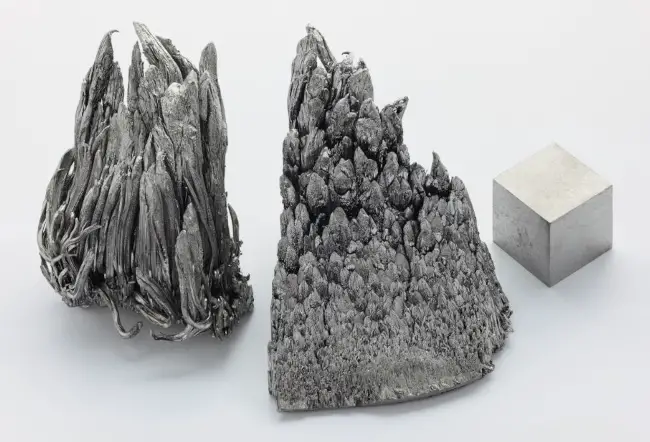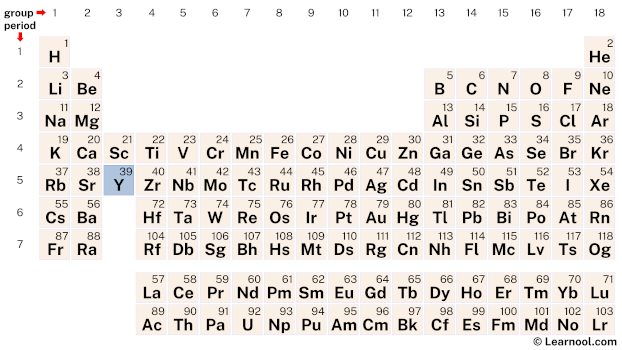
Yttrium (Y) is a chemical element of the periodic table, located in the group 3 and the period 5, and is having the atomic number 39. It is a soft, ductile, silvery-white transition metal, which is named after Ytterby, a village in Sweden, where it was mined. It is counted as one of the rare earth elements.
On periodic table
| group | ⇨ | 1 | 2 | 3 | 4 | 5 | 6 | 7 | 8 | 9 | 10 | 11 | 12 | 13 | 14 | 15 | 16 | 17 | 18 |
| period | ⇩ | ||||||||||||||||||
| 1 | 1 H  Hydrogen |
2 He  Helium |
|||||||||||||||||
| 2 | 3 Li  Lithium |
4 Be  Beryllium |
5 B  Boron |
6 C  Carbon |
7 N  Nitrogen |
8 O  Oxygen |
9 F  Fluorine |
10 Ne  Neon |
|||||||||||
| 3 | 11 Na  Sodium |
12 Mg  Magnesium |
13 Al  Aluminium |
14 Si Silicon |
15 P  Phosphorus |
16 S  Sulfur |
17 Cl  Chlorine |
18 Ar  Argon |
|||||||||||
| 4 | 19 K  Potassium |
20 Ca  Calcium |
21 Sc  Scandium |
22 Ti  Titanium |
23 V  Vanadium |
24 Cr  Chromium |
25 Mn  Manganese |
26 Fe  Iron |
27 Co  Cobalt |
28 Ni  Nickel |
29 Cu  Copper |
30 Zn  Zinc |
31 Ga  Gallium |
32 Ge  Germanium |
33 As  Arsenic |
34 Se  Selenium |
35 Br  Bromine |
36 Kr  Krypton |
|
| 5 | 37 Rb  Rubidium |
38 Sr  Strontium |
39 Y Yttrium |
40 Zr  Zirconium |
41 Nb  Niobium |
42 Mo  Molybdenum |
43 Tc  Technetium |
44 Ru  Ruthenium |
45 Rh  Rhodium |
46 Pd  Palladium |
47 Ag  Silver |
48 Cd  Cadmium |
49 In  Indium |
50 Sn  Tin |
51 Sb  Antimony |
52 Te  Tellurium |
53 I  Iodine |
54 Xe  Xenon |
|
| 6 | 55 Cs  Caesium |
56 Ba  Barium |
72 Hf  Hafnium |
73 Ta  Tantalum |
74 W  Tungsten |
75 Re  Rhenium |
76 Os  Osmium |
77 Ir  Iridium |
78 Pt  Platinum |
79 Au  Gold |
80 Hg  Mercury |
81 Tl  Thallium |
82 Pb  Lead |
83 Bi  Bismuth |
84 Po  Polonium |
85 At  Astatine |
86 Rn  Radon |
||
| 7 | 87 Fr  Francium |
88 Ra  Radium |
104 Rf  Rutherfordium |
105 Db  Dubnium |
106 Sg  Seaborgium |
107 Bh  Bohrium |
108 Hs  Hassium |
109 Mt  Meitnerium |
110 Ds  Darmstadtium |
111 Rg  Roentgenium |
112 Cn  Copernicium |
113 Nh  Nihonium |
114 Fl  Flerovium |
115 Mc  Moscovium |
116 Lv  Livermorium |
117 Ts  Tennessine |
118 Og  Oganesson |
||
| 57 La  Lanthanum |
58 Ce  Cerium |
59 Pr  Praseodymium |
60 Nd  Neodymium |
61 Pm  Promethium |
62 Sm  Samarium |
63 Eu  Europium |
64 Gd  Gadolinium |
65 Tb  Terbium |
66 Dy  Dysprosium |
67 Ho  Holmium |
68 Er  Erbium |
69 Tm  Thulium |
70 Yb  Ytterbium |
71 Lu  Lutetium |
|||||
| 89 Ac  Actinium |
90 Th  Thorium |
91 Pa  Protactinium |
92 U  Uranium |
93 Np  Neptunium |
94 Pu  Plutonium |
95 Am  Americium |
96 Cm  Curium |
97 Bk  Berkelium |
98 Cf  Californium |
99 Es  Einsteinium |
100 Fm  Fermium |
101 Md  Mendelevium |
102 No  Nobelium |
103 Lr  Lawrencium |
|||||
| – d block |
Yttrium is a d-block element, situated in the third column and the fifth row of the periodic table. Its atomic number is 39 and its symbol is Y.
Element information
 |
|
 |
|
| Origin of name | named after Ytterby, a village in Sweden |
| Symbol | Y |
| Atomic number (Z) | 39 |
| Atomic mass | 88.90585 u |
| Block | d-block |
| Group | 3 |
| Period | 5 |
| Classification | Transition metal |
| Atomic radius | 180 pm |
| Covalent radius | 190±7 pm |
| Melting point | 1526 ℃, 2779 ℉, 1799 K |
| Boiling point | 2930 ℃, 5306 ℉, 3203 K |
| Electron configuration | [Kr] 4d1 5s2 |
| Electrons per shell | 2, 8, 18, 9, 2 |
| Learn how to draw: Yttrium Bohr model | |
| Crystal structure | Hexagonal close-packed (hcp) |
| Phase at r.t | Solid |
| Density near r.t | 4.472 g/cm3 |
| Main isotopes | Yttrium-89 |
| Natural occurrence | Primordial |
| Oxidation state | +3 |
| Electronegativity (Pauling scale) | 1.22 |
| Protons Neutrons Electrons |
39 50 39 |
| CAS number | 7440-65-5 |
| Discovered by | Johan Gadolin in 1794 |
History

Yttrium was discovered in 1794 by Johan Gadolin, a Finnish chemist, while analyzing a heavy, black mineral that he had discovered in an old quarry. Gadolin named the mineral ytterbite after the village of Ytterby in Sweden, near where it was found.
The mineral was later found to contain four rare-earth elements in addition to yttrium: terbium, erbium, ytterbium, and gadolinium, all of which were eventually isolated and identified. In 1843, Carl Gustaf Mosander, a Swedish chemist, successfully separated yttrium oxide into two different substances which he named yttria and erbia. This discovery enabled scientists to study the properties of yttrium in more detail.
The metal itself was first isolated in 1828 by Friedrich Wöhler, a German chemist, by reducing yttrium chloride with potassium. However, it was not until the early 20th century that large-scale production of yttrium metal became possible.
Yttrium has since found a variety of applications, particularly in the fields of electronics, ceramics, and aerospace. Its unique properties, such as its ability to form stable compounds with oxygen, make it a valuable material for use in high-temperature applications, as well as in the manufacture of superconductors and lasers.
Occurrence and production
Yttrium is a rare earth element and it is not found in the Earth’s crust in its free state. Instead, it occurs in various minerals, such as yttrium aluminum garnet (YAG), monazite, xenotime, and euxenite. The primary source of yttrium is from ion adsorption-type rare earth element deposits, mainly located in Southern China.
The production of yttrium involves several steps. First, the rare earth elements are separated from the ore using solvent extraction or ion exchange. Then, the individual rare earth elements are separated from each other using various techniques such as precipitation, solvent extraction, and ion exchange. Finally, yttrium is isolated and purified from the other rare earth elements using ion exchange chromatography or solvent extraction.
Yttrium is also produced as a byproduct of other metal refining processes, such as copper refining. It can also be produced through the reduction of yttrium fluoride with calcium metal. However, this method is expensive and not widely used.
Overall, the production of yttrium is complex and expensive due to its low abundance and the need to extract and purify it from other rare earth elements.
Properties
It is a silvery-metallic transition metal.
Yttrium is a rare earth element and belongs to the lanthanide series.
It is highly reactive and forms a protective oxide layer when exposed to air, which prevents further oxidation.
Yttrium has a high melting point of 1526 ℃ and boiling point of 2930 ℃.
Its density is 4.472 g/cm3, making it slightly lighter than iron.
Yttrium is a paramagnetic material, meaning that it is weakly attracted to magnetic fields.
It has good electrical conductivity and is used as a doping agent in the production of certain semiconductors and high-temperature superconductors.
Yttrium has a strong affinity for oxygen and is used in alloys to improve high-temperature strength and corrosion resistance.
Applications
Yttrium is used as a dopant in various solid-state lasers for industrial and medical applications, such as in dental drills and cancer treatment.
It is also used in the production of phosphors for cathode ray tubes, fluorescent lamps, and LEDs, giving them their red and/or green color.
Yttrium oxide is used as a high-temperature refractory material, and as a coating for electrodes in solid oxide fuel cells.
Yttrium-barium-copper oxide is a high-temperature superconductor, and is used in magnetic levitation (maglev) trains and other applications.
Yttrium is used in the production of various alloys, including those used in the aerospace industry for aircraft parts, such as turbine blades, and in nuclear reactors as a structural material due to its resistance to neutron absorption.
Yttrium-aluminum-garnet (YAG) is a crystal used in optics and electronics, such as in camera lenses, laser pointer pointers, and microwave filters.
Interesting facts
Yttrium is named after the Swedish village of Ytterby, which is known for its rich concentration of rare earth elements.
Yttrium is a silvery-white metal that is relatively stable in air but reacts with water and acids.
Yttrium has no biological role but is considered to be non-toxic.
Yttrium has the highest melting point among the rare earth elements and is also a good conductor of heat and electricity.
Yttrium is commonly used as a component in alloys for various applications, such as in superalloys for high-temperature turbines, in stainless steel for improved strength and corrosion resistance, and in aluminum alloys for improved strength and durability.
Yttrium also has applications in electronics, including as a phosphor in television tubes and computer monitors, and as a component in superconducting materials.
Yttrium is used in medical imaging as a contrast agent in magnetic resonance imaging (MRI) and as a radiation source in cancer treatment.
Yttrium-90, a radioactive isotope of yttrium, is used in radiopharmaceuticals for cancer treatment and has also shown promise in treating certain bone disorders.
Related
More elements
External links
- https://www.rsc.org/periodic-table/element/39/yttrium
- https://en.wikipedia.org/wiki/Yttrium
- https://www.britannica.com/science/yttrium
- https://www.chemicool.com/elements/yttrium.html
- https://www.livescience.com/34564-yttrium.html
- https://pubchem.ncbi.nlm.nih.gov/element/Yttrium
- https://www.radiochemistry.org/periodictable/elements/39.html
Deep
Learnool.com was founded by Deep Rana, who is a mechanical engineer by profession and a blogger by passion. He has a good conceptual knowledge on different educational topics and he provides the same on this website. He loves to learn something new everyday and believes that the best utilization of free time is developing a new skill.
